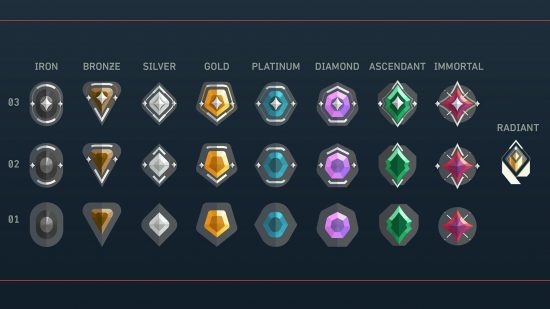What are the Valorant ranks in order? From the first mouse click of the game’s closed beta, Valorant has rapidly ascended to being one of the best shooters on the market. Sporting a robust ranked system, those at the top of the Valorant ranks can even stake their claim for a spot on a top team in the Valorant Champions Tour.
Like many of the best FPS games out there, Valorant is good fun to play casually, but its the game’s ranked mode where you’ll want to spend the most time on the Valorant maps. If you’ve mastered Valorant tier list staples like Sova and Viper, then you need to be playing ranked. So, sharpen your skills, find your perfect Valorant crosshair, and click some heads to start climbing the Valorant ranks.
All Valorant ranks in order
Here are the 25 Valorant ranks in order:
- Iron (1-3)
- Bronze (1-3)
- Silver (1-3)
- Gold (1-3)
- Platinum (1-3)
- Diamond (1-3)
- Ascendant (1-3)
- Immortal (1-3)
- Radiant
Valorant didn’t always have 25 ranks. In fact, at launch, it only had 22. Back in June 2022, Riot released the Ascendant tier alongside Episode 5 Act 1, in order to help smooth out the rank distribution curve that was too heavily skewed towards the lower end. The results were excellent, as the amount of players in Diamond 1 or above doubled in size within the first month of Ascendant being in the game. Now, the ranked system is in a much more stable and sustainable state, as you’re about to see with the latest data on rank distribution.
Valorant rank distribution
When it comes to Valorant rank distribution, there are some general rules of thumb. The majority of players sit somewhere between Bronze and Gold, while only ~1% of the player base will achieve Immortal. Radiant is reserved for the top 500 players of each region.
The latest Valorant rank distribution data for November 2023 is:
- Iron – 5.1%
- Bronze – 15.9%
- Silver – 22.5%
- Gold – 20.9%
- Platinum – 16.2%
- Diamond – 11.1%
- Ascendant – 4.8%
- Immortal – 2.0%
- Radiant – 0.05%
These stats were collated by Esports Tales, and paint a picture of the current competitive landscape in Valorant.
How to unlock Valorant ranked
If you’re looking to dive straight into Valorant’s ranked mode as soon as your game is finished installing, then we’ve got bad news for you: you can’t. To unlock access to Valorant’s ranked Competitive Mode you simply have to reach account level 20. Be sure to check out our Valorant account level primer to learn more about what that grind entails.
Prior to Episode 4, players only had to win 10 unrated matches to unlock Competitive Mode. This retired system made smurfing more accessible and didn’t give new players enough time to really get used to Valorant’s systems before jumping into the fires of ranked play. Needless to say, the current system is much better.
How do the Valorant ranks work?
Valorant’s ranking system works like most competitive games out there. Once ranked mode is unlocked by reaching account level 20, you’ll need to play five placement matches to determine your starting rank and your skill level.
Alongside your visual rank, Valorant uses a hidden matchmaking rating system, known as MMR, to rate players in ranked. Every player will have a number associated with their account that adjusts over time, placing them against other players of a similar value.
So what does this look like in practice? Well, a player whose visual rank is Silver could get matched into Platinum lobbies because their MMR is so high. As a result of this, they will be rewarded more Rank Rating (RR) for a win, and less for a loss as the system tries to bring their visual rank back up to where their actual skill level is.
At the start of a new Episode in Act 1, it’ll only take you five games to get a rank, but be aware: your MMR from the previous rank will be taken into account, so expect a more conservative placement at first where you can work your way back up the ranks. In other words, expect to be placed a few tiers below where you were in the previous Act, though always at 50RR to give you a fighting chance.
Fortunately, for Acts 2 and 3 in an episode, only one placement game needs to be played. Additionally, you’re unlikely to drop down in rank unless you have an absolute horror of a game.
How do I track rank progression in Valorant?
Your Valorant rank progress can be tracked using the leaderboard and progress bar in Match History, which can be accessed from the main menu via the ‘Career’ option. Not only can you check your current rank, but you can also see how well (or poorly) you performed in previous Acts.
To progress your rank, earn Valorant Rank Rating by playing matches. You will always gain RR in a win, and always lose RR in a loss. Winning or losing games by large round margins will also impact how much RR you gain or lose. Your individual performance can help you progress quickly through the lower ranks, though this is less impactful when you get to Immortal and Radiant.
You will gain between 10-50 RR for a win, lose 0-30 RR for a loss, and gain 0-20 for a draw. Between the Iron and Ascendant ranks, individual performance will be taken into account when calculating your RR.
You will always start at 10 Rank Rating after being promoted to a new rank, and a minimum of 70 after a demotion. This ensures you won’t automatically demote if you lose your first game post-promotion, while you won’t have far to climb back up if you do drop down a tier.
You can find each Episode’s rank rewards on the rank info page.
What are Valorant Acts and Episodes?
Acts are basically seasons in Valorant. Every Valorant Act will span about two months, and during that time, you’ll be able to work on your rank and track your overall progression. Three Acts make up an Episode, meaning Episodes last around six months.
It should also be noted that the Valorant Night Market arrives once per Act, offering a selection of Valorant skins at a discount price. You can check out the teaser for the latest Valorant season – Episode 7 Act 3.

Valorant Episode 8 release date
We expect Valorant Episode 8 to release on Tuesday, January 9, 2024. Valorant typically transitions seamlessly from Act to Act, and the current battle pass is set to end on that date. Additionally, new Valorant acts traditionally arrive on a Tuesday, so the stars very much align here.
With a brand new Episode on the way, expect new maps, agents, and balance updates to follow. Episode 7 Act 3 saw the release of new agent Iso, so we’re not expecting any new characters until much later in the Episode. As for maps, it’s perhaps too soon for us to see a new arena to test our pew-pew skills on. Sunset only arrived in August 2023, and maps typically drop every six months or so.
What are Valorant Act Ranks?
Valorant Act Ranks are a way of showing off your proven skill during and at the end of a season.
If you’re not sure how the Act Rank Badge triangles work, here’s a rough outline:
- Every time you play a match in an Act, your Rank Act badge will be filled with a new triangle representing the rank you played in.
- As you progress up the ranks, new triangles representing higher-ranked matches will replace the lower-ranked matches.
- The border for the badge will also change based on the number of wins you achieve in that rank.
- For some, their badge at the end of an Act will look pretty colorful, but for those at the top dominating Radiant, expect to see a solid gold triangle.
You can view your Act Rank badge at any time in the Career page.
Why does Valorant ranked allow premade teams?
Currently, Valorant allows parties of up to five people of any rank to queue together, so friends and loved ones won’t be isolated from one another. Five-stacks can play together, regardless of their ranks – albeit for less rank rating points. Here’s how it works:
If everyone in your group is Ascendant 3 and below:
- Expect longer queue times as you’ll only match against another five-stack of a similar average MMR
- Rank Rating gains and losses will be reduced by 25% when playing in a five-stack outside of rank restriction rules. The amount of RR you receive depends on the ranked disparity in the group
If one or more members of your group are between Immortal 1 and and Immortal 3:
- Expect much longer queue times as you’ll wait indefinitely until another five-stack of a similar average MMR
- The team will receive a 25% RR reduction penalty
If one or more members of your group are Radiant:
- Expect much longer queue times as you’ll wait indefinitely until another five-stack of a similar average MMR
- At a minimum, a 75% RR reduction will be applied
- Playing with any player below Radiant reduces your potential RR by 90%
As a result of the five-stack changes, four-stacks are no longer permitted in a bid to tackle toxicity towards solo queue players. Additionally, players in Immortal 1+ can only solo, duo, or 5-stack.
How to rank up fast in Valorant
When trying to improve and rank up fast in Valorant, there are several things that you should be looking to do or add to your game:
- Stop caring about your rank
- Play every game with the intent to improve
- Improve your chances of entering ‘flow state’
- Drill your fundamentals and warm up
- Keep your Agent pool modest
The first tip may seem counter-intuitive, but hear us out. Ranked anxiety is a very real issue for many, and refusing to queue up out of fear that you might demote, or lay out a red carpet in your match history could be the first obstacle that you need to clear. How can you rank up in Valorant if you don’t queue Competitive? Exactly.
When you do queue ranked, you need to go in thinking ‘I’m playing to improve, not to rank up.’ If you play with the intent to get better and pay full attention to the game, you’re going to see better results than if you obsess over RR. The key takeaway here is to work smarter, not harder, and we’d always rather play three games per day where we’re completely in the zone, checking economy and map state, and making note of why we died when we do, than six games per day on auto-pilot.
Speaking of the zone, you’re going to want to learn more about ‘flow state’. This is effectively what happens when you are so focused on a single pursuit that time dilates and your subconscious takes over, ramping your performance up to the max. It’s a high that many chase but never achieve, and ironically it’s because they’re often so preoccupied with chasing it that they can’t get into it. GameLeap’s explainer below is a good entry point into understanding flow state and how to enter it.

While the above are all external elements to work on, there are things you should also be doing in-game to up your skillset – namely working on fundamentals.
As a tactical shooter, Valorant requires more precision than traditional FPS games, as well as an intricate understanding of peeking angles, macro, line-ups, and more if you’re to ascend to the zenith of its ranked ladder. Aim training – our ‘how to get better at Valorant‘ guide has more on this – should play a major role in your daily warmup, which is something you should always endeavor to do even for the first ten minutes of your session.
Finally, as part of your practice regimen, you should learn all you can about your Agent(s) of choice. To begin with, we’d recommend only learning a few different Agents across the classes to provide enough versatility to your pool without overwhelming you. Once you’ve found your faves, take them into custom lobbies and learn the ranges and durations of their abilities, as well as their core line-ups – you don’t need to become a line-up Larry, but learn enough to give you tactical variation during a match.
That’s all we have on the Valorant ranks for now, but as Riot continues to refine and freshen up the ranked experience, we’ll be sure to update this guide. If you’re a console player looking for details on a Valorant console release date, then we’ve got plenty of info on that too. Hopefully, it won’t be long until you can play Valorant using your best PlayStation controller or best Xbox controller. Happy grinding!




